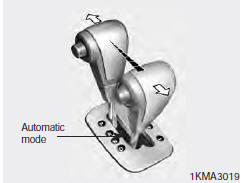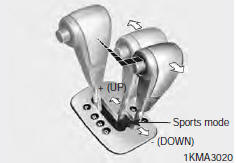 Kia Sportage: Automatic transaxle
Kia Sportage: Automatic transaxle


Automatic transaxle operation All normal forward driving is done with the shift lever in the D (Drive) position. To move the shift lever from the P (Park) position, the brake pedal must be depressed and the lock release button must be depressed. For smooth operation, depress the brake pedal when shifting from N (Neutral) to a forward or reverse gear.
WARNING - Automatic transaxle Before leaving the driver’s seat, always make sure the shift lever is in the P (PARK) position; then set the parking brake fully and shut the engine off. Unexpected and sudden vehicle movement can occur if these precautions are not followed in the order identified.
NOTICE • To avoid damage to your transaxle, do not accelerate the engine in R (Reverse) or any forward gear position with the brakes on. • When stopped on an upgrade, do not hold the vehicle stationary with engine power. Use the service brake or the parking brake. • Do not shift from N (Neutral) or P (Park) into D (Drive), or R (Reverse) when the engine is above idle speed.
Transaxle ranges P (park) Always come to a complete stop before shifting into P. This position locks the transaxle and prevents the front wheels from rotating.
WARNING - Automatic transaxle • Shifting into P (Park) while the vehicle is in motion will cause the drive wheels to lock which will cause you to lose control of the vehicle. • Do not use the P (Park) position in place of the parking brake. Always make sure the shift lever is latched in the P (Park) position so that it cannot be moved unless the lock release button is pushed in, AND set the parking brake fully. • Before leaving the driver’s seat, always make sure the shift lever is in the P (PARK) position. Set the parking brake fully, shut the engine off and take the key with you. Unexpected and sudden vehicle movement can occur if you do not follow these precautions in the order specified. • Never leave a child unattended in a vehicle.
NOTICE The transaxle may be damaged if you shift into P (Park) while the vehicle is in motion.
R (reverse) Use this position to drive the vehicle backward.
NOTICE Always come to a complete stop before shifting into or out of R (Reverse); you may damage the transaxle if you shift into R while the vehicle is in motion.
N (neutral) The wheels and transaxle are not locked. The vehicle will roll freely even on the slightest incline unless the parking brake or service brakes are applied. D (drive) This is the normal forward driving position. The transaxle will automatically shift through a 4-gear sequence, providing the best fuel economy and power. For extra power when passing another vehicle or climbing grades, depress the accelerator fully, at which time the transaxle will automatically downshift to the next lower gear.
NOTICE Always come to a complete stop before shifting into D (Drive).

Sports mode Whether the vehicle is stationary or in motion, sports mode is selected by pushing the shift lever from the “D” position into the manual gate. To return to “D” range operation, push the shift lever back into the main gate. In sports mode, moving the shift lever backwards and forwards will allow you to make gearshifts rapidly. The sports mode allows gearshifts with the accelerator pedal depressed. Up (+) : Push the lever forward once to shift up one gear. Down (-) : Pull the lever backwards once to shift down one gear. Snow mode When taking off from a standstill on a slippery road, push the shift lever forward into the +(up) position. This causes the transaxle to shift into the 2nd gear which is better for smooth driving on a slippery road. Push the shift lever to the -(down) side to shift back to the 1st gear.
NOTICE • Upshifts take place automatically in sports mode. However, the driver must execute upshifts in accordance with road conditions, taking care to keep the engine speed below the red zone because upshifts take place at the higher engine rpm. • In sports mode, only the four forward gears can be selected. To reverse or park the vehicle, move the shift lever to the “R” or “P” position as required. • In sports mode, downshifts are made automatically when the vehicle slows down. When the vehicle stops, 1st gear is automatically selected. • In sports mode, when the engine rpm approaches the red zone shift points are varied to upshift automatically.
CAUTION In the sport mode, if you push the lever to shift and no shift occurs, the system is acting to protect your safety and the vehicle.
Moving up a steep grade from a standing start To move up a steep grade from a standing start, depress the brake pedal, shift the shift lever to D (Drive). Select the appropriate gear depending on load weight and steepness of the grade, and release the parking brake. Depress the accelerator gradually while releasing the service brakes. When accelerating from a stop on a steep hill, the vehicle may have a tendency to roll backwards. Shifting the shift lever into 2 (Second Gear) while in Sport mode will help prevent the vehicle from rolling backwards. Shift lock system For your safety, the Automatic Transaxle has a shift lock system which prevents shifting the transaxle out of P (Park) unless the brake pedal is depressed. To shift the transaxle out of P (Park): 1. Depress and hold the brake pedal. 2. Start the engine or turn the ignition to the ON position. 3. Depress the lock release button and move the shift lever. When the ignition switch is in the ACC or LOCK position, the transaxle cannot be shifted from P (Park). If the brake pedal is repeatedly depressed and released with the shift lever in the P (Park) position, a chattering noise near the shift lever may be heard. This is a normal condition. Ignition key interlock system The ignition key cannot be removed unless the shift lever is in the P (Park) position. If the ignition switch is in any other position, the key cannot be removed.
 Manual transaxle
Manual transaxle
Manual transaxle operation The manual transaxle has five forward gears. Press
the clutch pedal down fully while shifting, then release it slowly. A special safety
feature prevents inadvertent sh ...
 Four wheel drive (4WD)
Four wheel drive (4WD)
Engine power can be delivered to all front and rear wheels for maximum traction.
Full-time 4WD is useful when extra traction is required on road, such as, when driving
on slippery, muddy, wet, o ...
See also:
Jump-starting procedures
If your vehicle has a discharged battery it can be jumpstarted
using a set of jumper cables and a battery in
another vehicle or by using a portable battery booster
pack. Jump-starting can be dan ...
Adjusting the Sound
Press the SOUND (TUNE) knob
repeatedly to display the BASS,
TREBLE, FADER, BALANCE, and
SVC (speed-sensitive volume
compensation) settings.
BASS - Adjusts the bass.
TREBLE - Adjusts the treb ...
4MATIC (permanent four-wheel drive)
4MATIC ensures that all four wheels are permanently driven. Together with ESP®
and ETS, it improves the traction of your vehicle whenever a drive wheel spins due
to insufficient grip.
WARNI ...
